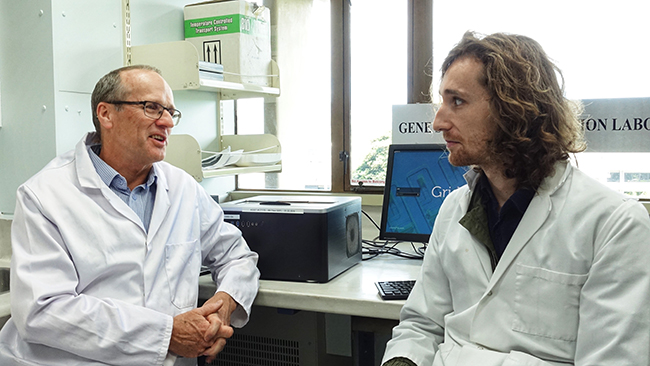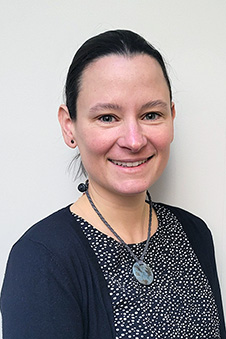 Professor Martin Kennedy and Oscar Graham in front of the nanopore sequencing device.
Professor Martin Kennedy and Oscar Graham in front of the nanopore sequencing device.
 Prof Tony Kettle
Prof Tony Kettle
Two research teams based in the Department of Pathology and Biomedical Science at the University of Otago, Christchurch are amongst the recipients of prestigious Marsden Grants announced by the Royal Society of New Zealand this week.
Professors Tony Kettle and Martin Kennedy won research grants totalling $1.9 million, for projects that respectively seek to understand how white blood cells fight infections and to explore genetic factors that underlie Parkinson's disease.
Professor Kettle will work with colleagues Dr Louisa Ashby and Dr Nina Dickerhof to examine how white blood cells use oxygen to kill bacteria that cause serious infections. Most of the oxygen the white blood cells consume is used to produce chlorine bleach. But it remains a puzzle how the bleach actually kills bacteria. The Christchurch researchers suspect other lethal molecules are produced from chlorine bleach. They will link up with Professor Bob Anderson at the University of Auckland to explore their chemistry.
 Dr Louisa Ashby
Dr Louisa Ashby
Professor Kennedy will work with PhD student Oscar Graham, colleagues Dr Toni Pitcher and Prof Tim Anderson at the New Zealand Brain Research Institute in Christchurch, Associate Prof Justin O'Sullivan from University of Auckland, and two Australian collaborators, Dr Jake Gratten from University of Queensland, Brisbane, and Associate Prof Antony Cooper from Garvan Institute of Medical Research, Sydney.
This group will explore the genetic and biological impacts of variation in a gene called GBA, which is the most common genetic factor underlying Parkinson's disease. People with mutations in GBA are at higher risk of getting Parkinson's disease, but this team has shown that even normal variation in the GBA gene can impact on disease risk.
Both of these projects will boost the internationally recognised research carried out at the University of Otago, Christchurch, generating new knowledge which in turn will lead to improved understanding of these diseases and their treatment or prevention.
Full summaries of projects:
Professor Anthony Kettle, Pathology and Biomedical Science, University of Otago, Christchurch, $960,000
 Dr Nina Dickerhof
Dr Nina Dickerhof
Neutrophils, our most abundant white blood cells, provide an essential front-line defence against pathogens. They consume vast amounts of oxygen when they kill bacteria, but the role oxygen plays in killing remains contentious. We aim to discover how and when neutrophils use oxygen to kill bacteria. Neutrophils ingest bacteria into specialized compartments, where they consume oxygen and discharge antimicrobial proteins. Half of the oxygen is converted to toxic chlorine bleach, the fate of the remaining oxygen is unknown. We showed that some bleach reacts with ingested bacteria and sometimes it is sufficient to kill them. Intriguingly, most of the bleach reacted with neutrophil proteins. The timing of bleach production was puzzling because in some compartments it appeared long after trapped bacteria should die. We will use radiation chemistry to mimic reactions of oxygen in neutrophil compartments, and mass spectrometry to identify the lethal oxidants neutrophils produce from oxygen. We will then use live cell microscopy to observe when these toxic species are formed in neutrophil compartments, and whether they always contribute to bacterial death. Our studies will show whether neutrophils use different strategies to kill each ingested bacterium, and thereby limit bacterial populations from evolving resistance to a specific toxin.
Professor Martin Kennedy, Pathology and Biomedical Science, University of Otago, $956,000
The most common, predisposing genetic risk factors for Parkinson's disease (PD) are mutations in a gene called GBA, which encodes an enzyme called glucocerebrosidase. Our team applied new technologies to discover that noncoding variation in GBA plays a major role in modifying the age at which PD occurs. This important finding arose from the application of nanopore sequencing, which can read long, single DNA molecules (haplotypes), to a well-studied New Zealand PD cohort. We found that the distribution of two common, normal haplotypes (with no GBA mutations) was associated with a five-year difference in age of onset. The key to understanding this effect comes from 3D genome analysis by our team, which identified a network of genes interconnected with, and regulated by, GBA. The two common, normal GBA haplotypes differ by only three tiny variants (single nucleotide polymorphisms) in non-coding regions of GBA. We will apply genomic methods to large PD cohorts, and in vitro studies of induced pluripotent stem cell (iPSC) models, differing in these GBA haplotypes, to understand the molecular and cellular basis of this dramatic clinical effect. The knowledge we gain will inform our understanding of PD, and guide efforts to clinically modify onset of the disease.